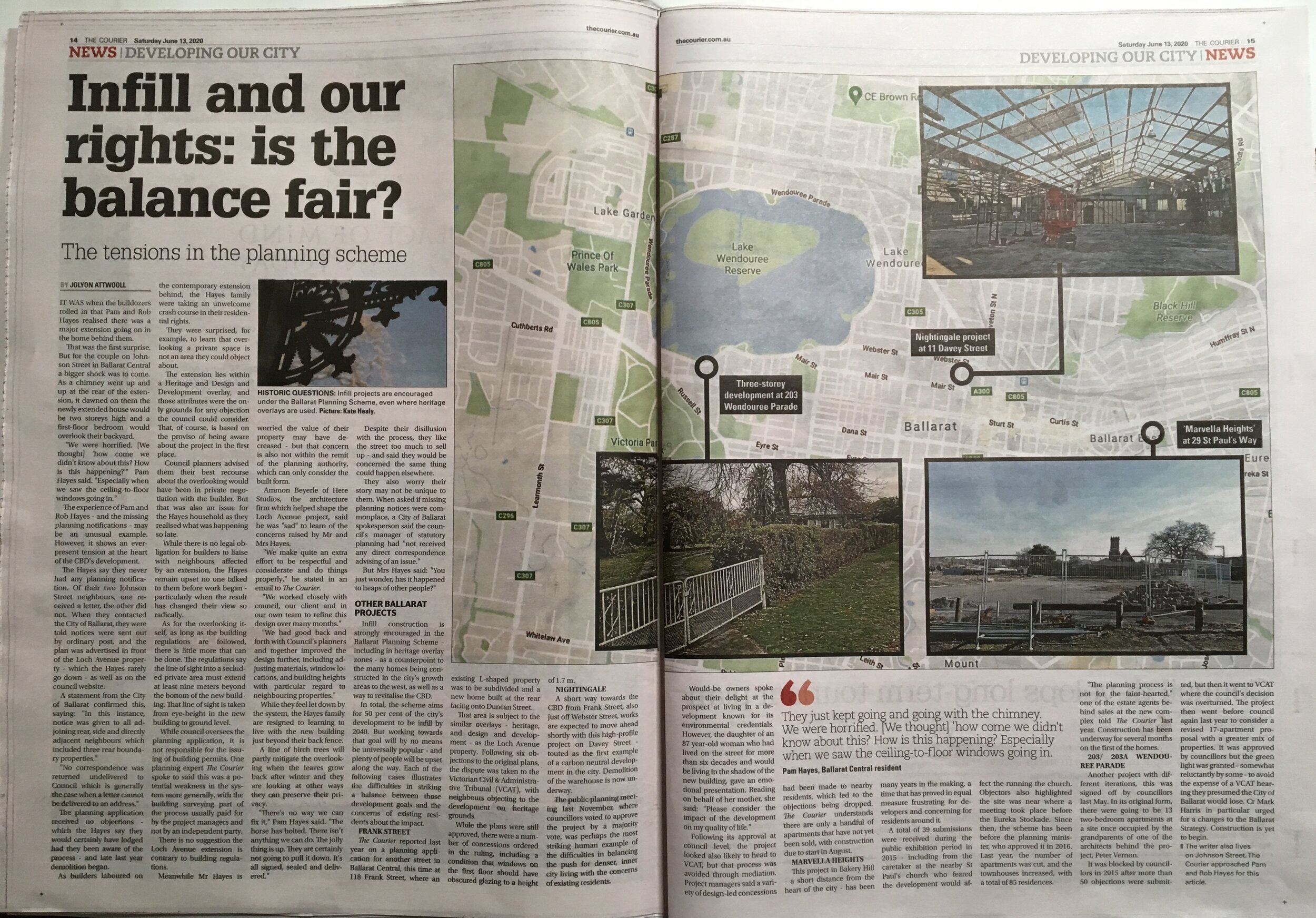Town Planning Permits and Rescode for heritage overlay sites
Here Studio architects was recently featured in the local newspaper The Courier regarding one of our residential extension projects
Last fortnight we were contacted by The Courier in Ballarat to discuss our residential extension in Loch Avenue, and the planning process. It was today published.
Although we have a good track record with Town Planning applications and permits, particularly in Ballarat, it is worthwhile discussing just how challenging our work can be at times to balance the competing interests, rules and regulations. Sometimes the decisions are quite line-ball, and some local Councils can be difficult to work with. The following is a short, off the cuff case-study.
IMAGE SCAN: Infill and our rights: is the balance fair? The tensions in the planning scheme, by Jolyon Attwooll, The Courier, 13/6/2020
Working collaboratively with local Councils
Here Studio tends to take a collaborative and considerate tone with local Councils throughout the planning process. We tend to develop good relationships. The local Council is the authority if a planning permit is required, and makes an independent decision of whether or not to grant a permit, well before the project is documented for construction. We understand that Town Planning is a complex thing and that the local Councils need to balance internal policies, Council plans, the formal Planning Scheme which is approved by the State Minister of Planning, and also take into account sustainable city strategy - such as what is the intended way the town should develop in the long term, against the existing context which is often rich with physical and social heritage.
In general the two key concerns of Town Planning are about the relationship to the existing neighbourhood in terms of:
use (function); and
look (aesthetic, form, finish).
In this instance of the Loch Avenue project the City of Ballarat were excellent to work with. We first presented our work in progress after the Concept Design was agreed by our client, at the start of Design Development. The initial pre-planning meeting included site photos, reference to the planning scheme, plans, reports and advice from specialist consultants (such as a structural, civil engineer, and land surveyor), a 3-dimensional digital model, street level perspectives, elevations, and examples of work from the Concept Design stage, including precedent images. We had a number of meetings and back and forth emails including reviewing issues that weren’t explicitly covered in the planning scheme - such as ResCode. When we approach these meetings and interactions we see that we are all on the same team, trying to get the best for the project, site, and context.
Applying for a Planning Permit
Typically a project is ready for Town Planning once the design is about 80-90% complete. In particular it requires that the exterior is finalised, windows openings etc, and that all the interior functions (such as room locations) are clear and working. Once the project and design is ready, we then write a detailed report that addresses each item in the planning scheme. Often the wording of the Planning Scheme is difficult to read and requires a fair bit of experience. It is laid out in a way that describes the objectives In this instance, the project was in a General Residential Zone, had a Design and Development Overlay and a Heritage Overlay. There was also a policy of a Central Ballarat Heritage Precinct to consider. Each overlay or zone document be accessed online, and normally has a separate schedule to also consider.
Finally, when we are ready, and have also checked the design with our client, and specialist consultants, and referred to samples, materials and the budget, we send a full drawing package, and written report to Council to review. For the Loch Avenue project the written report consisted of 7 pages, and covered the full range of topics to be considered by Council under the following headings:
Introduction
Subject Site
Planning Zone and Overlays
Existing Conditions Evaluation
Surrounding Area
Transport
The Proposal
Details of the Proposed Use and Development
Use
The proposed building
Car parking and access
Landscaping
Design and Development Overlay Schedule 7 - Urban Character Area 11
Heights
Roofs
Setbacks
Garage Setbacks
Front Fences
Landscaping
Design Details
External Construction Materials
Corner sites
Central Ballarat Heritage Precinct
Historically significant at a local level
Aesthetically and architecturally significant at a local level
Scientifically significant at a local level
Socially significant at a local level
Conclusion
For Loch Avenue the City of Ballarat Town Planning application also included a visual document of 13x A3 drawings, including:
Cover Page
Site Plan
Neighbourhood & Site Description
Existing Residence Images
Existing Floor Plan
Demolition Plan
Existing Elevations
Proposed Ground Floor Plan
Proposed First Floor Plan
Proposed Roof Plan
Proposed Street Views
Proposed Elevations 01
Proposed Elevations 02
A Town Planning application also requires a fee to be paid and filling out an application form that includes our client’s approval. Fees today are typically around $600 - $1500 depending on the scale of the project.
Waiting for a planning permit assessment
Typically Town Planning Permits take about 2 months – 60 days to assess. This means that when the project is in with Council it may be best that the project pauses. Some early work for the Construction Documentation set can be commenced, yet there are always risks of further changes required by Council as the authority. There are rules that Council should make a decision in a particular time period, however, there are many loopholes to extending this, so it is often extended and requires a fair bit of follow-up by the architect – emails and phone calls…
For more complex or controversial sites, Council may escalate the decision to the elected Councillors who vote in the Council Chamber. However, for most projects the Council Officer – a public servant – will assess the application and consult internal and external experts to do so. In the instance of the Loch Avenue project this included Council’s heritage architect, and some modification of the design.
For Loch Avenue the approval from submission to permit took 84 days. In this time there was further back and forth, including altering the design and amending the drawings. Before a decision was made the application was advertised (a sign out the front of the property, and online at Council, and letters to neighbours). We received feedback from neighbours and responded by making changes to the design. When we made these final changes we checked again with our client and against the Building Code - the National Construction Code. Our client decided to take the risk to progress the Construction Documentation whilst the project was in with Council, pausing only 1 month.
Finally we received a Town Planning Permit in the form of a letter, with conditions, and stamps on each of our submitted plans, signed by the Council Officer.
Next steps for architects after a Planning Permit is received - a Building Permit
There is a need for ongoing contact with the Council following receipt of a Town Planning permit. This is to satisfy conditions of the permit, obtain property information, access archives of existing drawings, review any final changes, determine the Legal Point of Discharge (where the stormwater exits the site) and obtain Secondary Consent (approval of final changes to the design). Following Council, the client (via the architect) engages another authority, a Building Surveyor who provides a Building Permit before construction can commence.
The Building Surveyor checks the design and documentation before construction starts to make sure it is:
good quality (meets the Building Code - the National Construction Code)
carried out by registered building practitioners (Builders / Contractors, architects, engineers)
The Building Surveyor is typically independent of Council. Legislation changed in Victoria in 1994 and since 2009-10 almost all Building Permits (85%+) are issued by independent Building Surveyors rather than the Municipal Building Surveyor. (This has had pros and cons. In some ways the Building Permit process is more timely, in other ways it is less consistent.) The Building Surveyor also checks the proposed project against the Planning Permit, and Rescode, and requires that Insurance for the project is in place before it starts.
In the Loch Avenue project, the Building Permit was issued 7 months after the Planning Permit.
Controversy around Planning Permits for residential architecture
Almost all projects receive objections from neighbours during the Town Planning application process. In fact, in Victoria the system is relatively adversarial in that it defines comments and discussion from neighbours as “objections”. The language is often concerning for a client, it could probably be improved. Working in urban areas, especially in cities like Ballarat with a rich building fabric, stories, and lovely heritage streets, there is always a tension between the perceptions, conservation and basic maintenance of the existing built heritage, and the needs for change.
Most urban areas in Australia need to densify to become much more sustainable –such as reducing car travel and increasing accessibility. On top of that, many old buildings are expensive to run and maintain - requiring real upgrades to meet new standards. The approach most Councils and Heritage Architects apply to these changes is to respect the old by allowing change, seeing clear relationships between old and new buildings, seeking sophistication in design resolution, and encouraging improvements that would give longevity, sustainability, comfort and increased density. Sometimes decisions are made by elected Councillors who often make decisions based on public opinion.
One rule that can often be confusing for clients is Rescode. Rescode is a set of rules that works as a catchall to keep a minimum design quality in the absence of Town Planning. We consider it for all of our residential projects. It concerns building height, overlooking, private open space, and setbacks.
In the Loch Avenue project the dwelling density wasn’t changed (there was no subdivision or nor extra home created), instead an extension was added, the rear poor-quality part of the house removed and the front original house was restored and renovated. To satisfy Rescode the building was lowered (sunken) into the ground, the walls and roof forms chamfered, some windows obscured, and others set back.
The Town Planning process needs judgement and care
Debates around change in urban areas often revolve around the process and transparency, with demands such as fairness, propriety and rights, and concepts such as ‘not in my backyard’, ‘sustainability’ and ‘urban character’ at odds. It is never black and white, yet can be quite emotional, especially when it comes to building in and around other people’s homes. As radical as it might sound, Here Studio’s practice sees value in these tensions. They help the creative process and establish meaning.
Good architecture requires complex thinking and collaboration of many people, including of the architect to other people, such as technical and non-technical experts beyond the client. We work hard for our clients, and work to act responsibly. As an architect our approach to embarking on the planning process is to keep ambitions high and remember that the process needs judgement and care.

